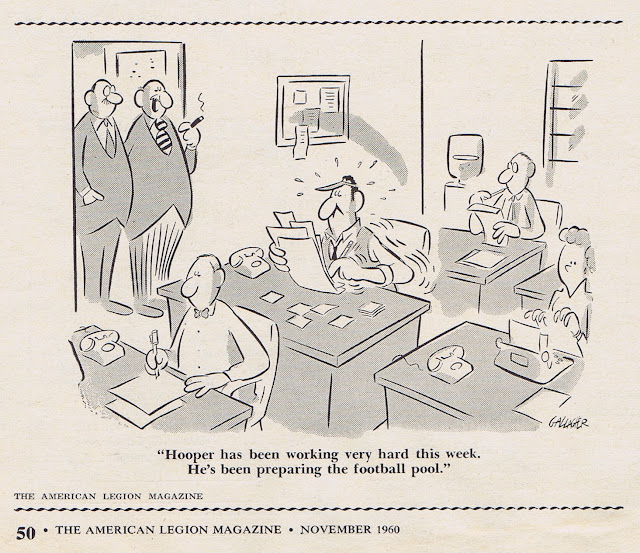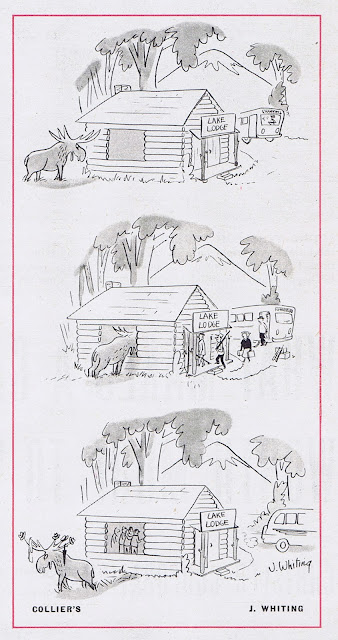INTRO: John Gallagher gets a great write up about his life and his cartooning career by Dick Buchanan. Dick did a lot of research into this, and I'm grateful that the Gallagher family was happy to help. The rest of this is written by Dick, who will show and tell you the story of the amazing cartoonist John Gallagher:
---
Occasionally the Cartoon Clip File spotlights an important cartoonist from the Golden Age of Gag Cartooning. This time we take a look at the work of cartoonist John Gallagher, one of the most prolific and funniest gag cartoonists of the era—or any era, for that matter. Our thanks go to John Gallagher’s son, Michael and his nephew, Peter Gallagher for providing a huge amount of biographical material
JOHN GALLAGHER
(Gag cartoons 1951-1970)
John Gallagher was born in Englewood, New Jersey in 1926. He received the National Cartoonist Society’s Gag Cartoonist Award for 1957 and 1971. His brother George Gately created the comic strips Hapless Harry and the incomparable Heathcliff.
Gallagher’s father, renowned for his sense of humor, was a longshoreman who had always wished to be a cartoonist. He and his wife encouraged John’s and George’s artwork. John Gallagher began drawing Mickey Mouse and Popeye at the age of three. After John and George became professional cartoonists, their father clipped hundreds of cartoons from magazines and glued them in spiral bound notebooks for their reference. He also took over the bookkeeping aspects of his sons’ cartooning activities.
During World War II, Gallagher served as a Navy Signalman. After the war he attended Syracuse University School of Art on the G.I. Bill. It was there he met cartoonist Brad (Marmaduke) Anderson, who became his lifelong friend. Anderson showed him how to put together cartoons for submission to magazines. After two years, John transferred to Pratt Institute, majoring in Illustration.
In 1951, his senior year at Pratt, John Gallagher sold his first cartoon to The Saturday Evening Post—submitted by mail. He married Dorothy “Dot” Lotter and moved to New York City where he became a staff artist for the Howell-Rojin Agency, which helped pioneer TV “green screen” technology still used today by TV news weathermen. At this time, he began submitting cartoons on a regular basis. When his freelance career began to take off, he and Dot moved to Bergenfield, New Jersey.
For the next 20 years, Gallagher enjoyed an immensely successful gag cartoon freelancing career. He was one of the greatest “Big Foot” style cartoonists and a superlative gagman. Readers and editors alike found his cartoons to be just plain funny. They appeared in magazines such as The Saturday Evening Post, Collier’s, Look, American Legion, Sport, Military Life, True, Golf, Argosy, Parade, Saga and Boys’ Life. In the late 1960’s he penned “The Cartoon Bug,” an advice column for aspiring cartoonists which was later syndicated to newspapers in the United States and Canada.
In the 1960’s, Gallagher attempted to crack the syndicated comic strip market with projects which never sold but nonetheless remain memorable to many in the industry. One was Joe Bucket, a tiny robot who lived with the wacky scientist who accidently created him, a stereotypical hobo, a dog and his flea, etc. (the ‘joe bucket” was Navy slang a ship’s coffee pot) When cartoonist Johnny Hart was making the rounds attempting to sell his comic strip B.C., one editor was discussing with him how he needed to make it better. As Hart was asking for guidance, the editor opened his drawer and pulled out Gallagher’s Joe Bucket strip and said “Take a look at this. This is funny.” Johnny Hart was already a huge Gallagher fan. He corresponded with Gallagher in the 1980’s asking about “the little robot strip.”
The magazine cartoon market began to dry up in the late 1960’s, prompting John to leave freelancing to become Art Director for American Kitchen Foods. He designed packaging and promotional material for their new frozen French fry products, including “Tasti Fries.” During this period, he also began a long association with fellow cartoonist Bob Weber, supplying gags for his syndicated comic strip, Moose.
When his brother, George Gately, launched his syndicated panel,
Heathcliff (McNaught/Creator’s Syndicate) in 1973 John became
Heathcliff’s primary gagwriter and layout penciler until shortly before
his death in 2005. Today Heathcliff is drawn by their nephew, Peter
Gallagher.
Here is a selection of gag cartoons by John Gallagher . . .
1. The Saturday Evening Post December 6, 1951.
2. Here! March, 1952.
3. Collier’s August, 1952.
4. Collier’s February 7, 1953.
5. American Legion Magazine June, 1954.
6. American Magazine April, 1954.
7. Collier’s January 21, 1955.
8. Sport Magazine May, 1955.
9. The Saturday Evening Post July 20, 1957.
10. American Legion Magazine August, 1958.
11. The Saturday Evening Post February 8, 1958.
12. Sport Magazine February, 1959.
13. American Legion Magazine November, 1960.
14. The Saturday Evening Post October 22, 1960.
15. True Magazine August, 1961.
16. The Saturday Evening Post October 6, 1962.
17. True Magazine March, 1962.
18. Boys’ Life July, 1965.
19. True Magazine January, 1967
20. True Magazine February, 1970.
Thursday, February 28, 2019
Wednesday, February 27, 2019
From the Dick Buchanan Files: Caption-less, Wordless Gag Cartoons 1946 – 1963
My friend Dick Buchanan has dug deep into his clip file of golden age magazine panel cartoons to come up with 15 caption-less gems. Ten of them don't even have a sign or written words as part of the art. Here are some great ones by some cartooning legends. Thank you, Dick!
---
Caption-less, Wordless Gag Cartoons
(1946 – 1963)
Here is yet another installment of vintage gag cartoons which are caption-less, wordless or, if you will, sight gags.
As usual, minimal reading required to appreciate these classic cartoons by some of the best cartoonists of the mid-century era, haphazardly plucked from Cartoon Clip File . . .
1. ROY WILLIAMS. American Legion Magazine January, 1947.
2. BO BROWN. The Saturday Evening Post October 1, 1960.
3. LLOYD BIRMINGHAM. The Saturday Evening Post December 13, 1947
4. CHARLES E. MARTIN (CEM). The Saturday Evening Post May 8, 1948.
5. IRWIN CAPLAN. The Saturday Evening Post May 8, 1948.
6. LARRY HARRIS. 1000 Jokes Magazine Spring, 1951.
7. HARRY LYONS. True Magazine October, 1958.
8. LEE PURCELL. The Saturday Evening Post February 11, 1950.
9. SALO ROTH. Judge October 26, 1953.
10. GAHAN WILSON. Collier’s March 4, 1955.
11. JIM WHITING. Collier’s, circa 1950’s.
12. GEORGE SMITH. The Saturday Evening Post. November 29, 1949.
13. MARTIN FLICHOCK. Collier’s March 2, 1946.
14. STAN HUNT. The Saturday Evening Post May 8, 1948.
15. DAVID PASCAL. The Saturday Evening Post November 2, 1963.
---
Caption-less, Wordless Gag Cartoons
(1946 – 1963)
Here is yet another installment of vintage gag cartoons which are caption-less, wordless or, if you will, sight gags.
As usual, minimal reading required to appreciate these classic cartoons by some of the best cartoonists of the mid-century era, haphazardly plucked from Cartoon Clip File . . .
1. ROY WILLIAMS. American Legion Magazine January, 1947.
2. BO BROWN. The Saturday Evening Post October 1, 1960.
3. LLOYD BIRMINGHAM. The Saturday Evening Post December 13, 1947
4. CHARLES E. MARTIN (CEM). The Saturday Evening Post May 8, 1948.
5. IRWIN CAPLAN. The Saturday Evening Post May 8, 1948.
6. LARRY HARRIS. 1000 Jokes Magazine Spring, 1951.
7. HARRY LYONS. True Magazine October, 1958.
8. LEE PURCELL. The Saturday Evening Post February 11, 1950.
9. SALO ROTH. Judge October 26, 1953.
10. GAHAN WILSON. Collier’s March 4, 1955.
11. JIM WHITING. Collier’s, circa 1950’s.
12. GEORGE SMITH. The Saturday Evening Post. November 29, 1949.
13. MARTIN FLICHOCK. Collier’s March 2, 1946.
14. STAN HUNT. The Saturday Evening Post May 8, 1948.
15. DAVID PASCAL. The Saturday Evening Post November 2, 1963.
Tuesday, February 26, 2019
THE KATZENJAMMER KIDS by Joe Musial
Hello
Dollinks! Here are a few hi res scans from the tiny KATZENJAMMER KIDS
paperback collection of Sunday strips by Joe Musial. It's copyright 1970
by King Features.
THE
KATZENJAMMER KIDS were created by Rudolph Dirks who, at William
Randolph Hearst's request, nicked them from the German cartoon MAX AND
MORITZ.
"The
strip relates in the frenzied style the war-to-the-death carried on by
Hans and Fritz against any form of authority, whether parental,
educational, or governmental."
I
had this paperback when I was a kid and studied it. It was lost and so,
last week, I bought a copy off of eBay. Such wonderful manic writing
and terrific cartooning by Musial. Reading it now for the first time
since I was nine years old, I was surprised at how many of the gags I
remembered.
Obviously, these are great fun (if not politically correct) to read out loud.
That last panel, where Hans and Fritz kiss with a "smak!!" is funny and chilling and perverse at the same time.
Monday, February 25, 2019
Tomi Ungerer 1931 - 2019
The artist and writer Tomi Ungerer died on February 9, 2019. He was 87 years old. The author of 140 books for children as well as adults, he was known for biting social satire and whimsy. He was a unique voice, and a fellow I always wanted to meet.
He was, in the past couple of years, a favorite rediscovery of mine. I had seen one of his Mellops stories in an old Children's Digest I bought. While in Montreal a couple of years back, I bought one of his collections of risque drawings from a street vendor. Here are a few of his works thru the years.
Related:
NY Times obituary
Excerpt from the new Comics Journal interview
He was, in the past couple of years, a favorite rediscovery of mine. I had seen one of his Mellops stories in an old Children's Digest I bought. While in Montreal a couple of years back, I bought one of his collections of risque drawings from a street vendor. Here are a few of his works thru the years.
Related:
NY Times obituary
Excerpt from the new Comics Journal interview
Subscribe to:
Comments (Atom)



























































